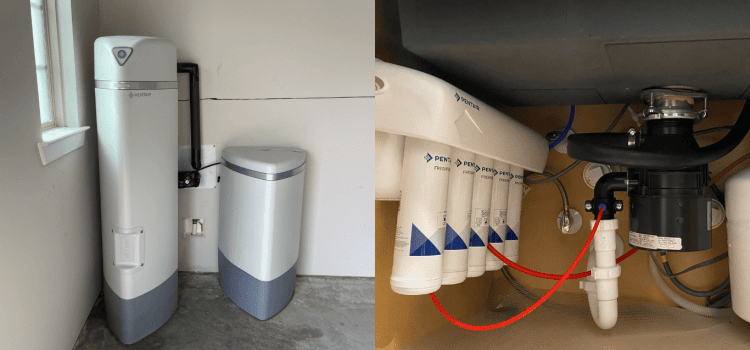Some customers will ask us to explain the difference between a water softening system and reverse osmosis. So, here’s a quick primer on the topic that we hope can help.
What Does a Water Softening System Do?
A water softener’s main role is to remove particles of calcium and magnesium – the two primary elements that make your household’s water “hard.” Why would you want to do this? Hard water can cause a number of problems for homes, including:
- Dry or damaged skin
- Lifeless or dull hair
- Ugly scaling on sinks and drains
- Shortening the life of appliances and increasing energy costs
- Clogging pipes and drains
- Creating a “chalky” or “metallic” taste to your water
Some top-of-the-line systems – such as the Pentair Pro Elite that we install – also may remove hard metals, algae, fungi, and other some other contaminants.
Often called “whole-home water conditioners,” water softening systems are generally installed where your water line comes into your home so that it softens water throughout the house. The reason why that’s the case is that hard water will generally affect every point at which you personally use water (kitchen, bathrooms), as well as all your appliances that have water lines attached to them, such as dishwashers, clothes washers, and refrigerators.
Houston’s Hard Water Problem
Hard water is a very big problem in Houston. According to a recent survey, Houston’s water averages about 8 grains per gallon (gpg), which is considered “hard” by the Water Quality Association. Hence, installing a water softener in the Houston area has a number of benefits, including saving on your energy and appliance bills, reducing the cleaning required for sinks and drains, improving your skin and hair, and even making your water taste better.
What Does a Reverse Osmosis System Do?
So, you might ask: Isn’t a water softener all I need? The answer is it depends on what’s in your water. One thing to remember about most water softeners – even some top-of-the-line units that offer additional filtration – is that impurities may still remain in the water you drink and when you wash foods and cook.
That’s why many households pair a water softening system with a point-of-use reverse osmosis unit. Reverse osmosis can remove those impurities from your already-softened drinking water, including lead, arsenic, PFAS chemicals, pesticides, E.coli/bacteria, and a lot more. Reverse osmosis systems can provide that extra layer of protection especially when it comes to your family’s health, as many of the contaminants it removes can cause life-threatening or severe illnesses if regularly ingested by humans. Reverse osmosis systems are typically installed in the kitchen (and can be connected to the line going to both your kitchen sink and refrigerator.)
How does it work?
Basically a water purification process, reverse osmosis uses a partially permeable membrane to separate contaminants, unwanted molecules, and other particles from drinking water. In most cases, a total RO system is actually made up 3 or 4 different levels of filtration (including one reverse-osmosis-specific filter) and may include a number of steps:
- A sediment filter that traps particles, including rust and calcium carbonate
- A second sediment filter with even smaller pores
- An activated carbon filter to trap organic chemicals and chlorine
- A reverse osmosis filter
- An ultraviolet lamp that may be used for sterilizing any microbes that may escape filtering by the reverse osmosis membrane
- A second carbon filter to capture those chemicals not removed by the above processes.
Why Reverse Osmosis and Softening Work Well Together
Given the complementary goals of the two systems, many households pair a point-of-use reverse osmosis system with a whole-home water conditioner. Some of the key benefits to doing this include the following:
- Highest Quality Water. Think of it this way, you get all the benefits of softer water that we mentioned above, along with removing all the dangerous chemicals, leaving only the highest quality water behind.
- Cost Savings. With both the water softening unit and a reverse osmosis system, you’ll save money. Water softening means you’ll reduce your energy costs, won’t have to replace your appliances as often, and you’ll need fewer products to keep your skin and hair soft and healthy. Meanwhile, with a reverse osmosis system, you won’t have to buy store-bought, single-use bottled water anymore. On average, you can save around $800 to $1,500 per year by just drinking water directly from your tap.
- A Softener Will Protect Your Reverse Osmosis Unit. Although there is usually a small sediment filter in front of most systems, the process of reverse osmosis doesn’t really address the reduction of calcium and magnesium – the minerals that make water hard. So, by installing a water softener together will act as a protective barrier for your RO system, extending its life.
Conclusion
We hope this article has been helpful. Get started today by requesting a free water quality analysis from us. We’ll test your water for contaminants and hard water particles, get you the results fast and then recommend the right solution for you.
